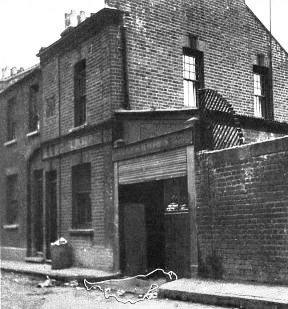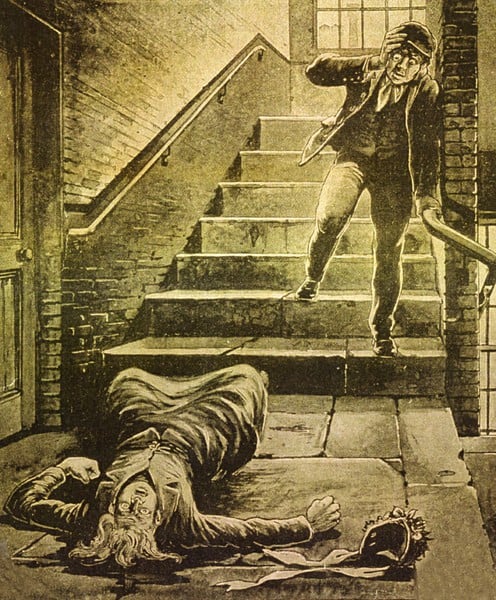Today, I am pleased to hand over to author Philipp Röttgers, who begins the first of an episode by episode look at the TV series Whitechapel.
Over to you Phillip.

FASCINATION WITH JACK THE RIPPER
There has been a great fascination with Jack the Ripper since he murdered five women in London’s East End in 1888 and was never caught. From the very first murder until today a huge mystery has been built around the unknown murderer, who is known to be the world’s first serial killer.
Apart from academic publications, there are lots of fictional representations of the Ripper and his killings. Jack the Ripper has also entered the area of TV series. The TV series Whitechapel chooses a fascinating approach to the topic: The first season deals with a Jack the Ripper copycat killer in 2008 and the police force in Whitechapel has to stop the murder from stepping into his idol’s footsteps.
The series is very well written and full of details and references to the actual 1888 investigation.
In this blog I will point out these parallels, and also some differences, and perhaps also include the question if a modern police force could have caught the Ripper – or perhaps if the approach of the Whitechapel writers can even be helpful for solving the real Ripper case.
Beware of spoilers!
THE TV SHOW WHITECHAPEL
Whitechapel is a British TV series created by Ben Court and Caroline Ip. It ran from 2008 to 2013 and deals with Detective Inspector Joseph Chandler and his team from the Whitechapel police station, as they investigate homicides which seem to be copycat killings based on historical crimes.
The series “stars Rupert Penry Jones as Detective Inspector Joseph Chandler, Phil Davis as Detective Sergeant Ray Miles and Steve Pemberton as Edward Buchan.
The series had four seasons, the first series dealing with gruesome murders of a Jack the Ripper copycat killer and the second revolving around the crimes committed by the notorious Kray twins, while the third and the fourth are not about copycat killers, but deal with the investigators using crimes of the past (like the Ratcliffe Highway murders or the Thames Torso murders) to solve modern-day murders.
The first season of Whitechapel consists of three episodes.
PARALLELS BETWEEN THE MURDERS AND THE SERIES
1.1 Season 1, Episode 1
The episode starts with the names of the actors and staff combined with images of a dark figure in a coat and a hat walking the alleys of Whitechapel (the way the Ripper is perceived nowadays) and of modern-day London, like Tower Bridge and which did not exist in 1888. There is also a flash-forward when we see the culprit from the series drowning in the Thames, like Ripper suspect Montague John Druitt.
At the end of the intro we meet Detective Inspector Joseph Chandler. The name is no coincidence. After the death of the second Ripper victim Annie Chapman the first officer on the scene was Inspector Joseph Chandler. The intro finishes with scenes of a fire and troubles between community support officers and civilians in Wilkes Street in Whitechapel.
THE FIRST VICTIM
After some scenes between Chandler in the company of the high society of British police and the troubles in the East End, police officer Mary Bousfield stumbles upon the first victim of the new Ripper, who literally dies in her arms, while she watches the Ripper walk off. The scene is similar to the story of PC Ernest Thompson, who found the dying Frances Coles and stayed with her while he heard footsteps (presumably of her attacker) speeding away into the night. When the Ripper vanishes into thin air at the end of the scene, it is a parallel to the ‘ghost’ of the Ripper that still haunts the streets of Whitechapel nowadays.
The police team, led by Detective Sergeant Miles and new Detective Inspector Chandler arrive at the crime scene. Apart from the two, the team consists of DCs Fitzgerald, McCormack, Sanders and Kent. Miles informs Chandler about the victim and tells him that she is “43 years old, mother of three, separated from her partner” – just like Mary Ann Nichols, the first Ripper victim.
Pathologist Dr Caroline Llewellyn, who is named after Dr Rees Ralph Llewellyn, the local doctor who pronounced Polly’s death at the scene her murder, explains the victim’s injuries, which are also similar to Polly’s.
DS Miles points out that “there’s not much blood”. When Polly was found, there was only a small pool of blood visible where the woman was lying, about half a pint.
After interrogating Mary Bousfield, Miles suspects a butcher, the victim’s boyfriend Rob Lees of committing the crime. Rob’s name comes from the spiritualist medium Robert James Lees who is supposed to have identified the Ripper by his clairvoyant powers.
Also, the search for a butcher was the first logical step after Polly’s murder back in 1888.
Miles wants Rob Lees’ flat to be watched. This is standard police work in 2008, but also in 1888 some suspects were also under surveillance, a famous example being the investigation of a suspect from “Butcher’s Row” in Aldgate – which is underlined in the next scene when Chandler and Miles enter a butcher’s market in search for Rob Lees.
In the mortuary, pictures of the victim are taken, like in 1888. When Dr. Llewellyn lifts the skirt and sees the mutilations, she says: “Welcome to hell, Gentlemen”, a hint at the comic From Hell.
In Polly Nichol’s case, the mutilations were also discovered when Inspector John Spratling was lifting the woman’s clothing at the mortuary.
Miles says that Mary Bousfield pulled the skirt down when she found the woman, similar to Charles Cross and Robert Paul, who had discovered the body of Polly Nichols in 1888. The description of the wounds given by Dr. Llewellyn is almost a citation of the autopsy report from Polly Nichols.
Since Miles is very keen on arresting Rob Lees, he wants Llewellyn to draw the conclusion that a butcher’s knife was used to mutilate the woman.
In that way, he is similar to Detective Sergeant William Thick, also known as ‘Johnny Upright’, who was very keen on arresting John Pizer (who turned out to be innocent).
This is also the case with Rob Lees, who is interviewed by Chandler and Miles in the next scene and provides an alibi.
During the interview, we find out that it is the 31st of August 2008, exactly 120 years after the murder of Polly Nichols.
In the investigation room, Chandler describes the man seen by Mary Bousfield to the team: “Right, our suspect is in his forties, average height and build, dark complexion and wearing a hat with ear flaps.” This description fits many of the descriptions of men seen with the Ripper victims shortly before their death.
A JACK THE RIPPER TOUR GUIDE
Enter Edward Buchan, a Ripperologist who does Ripper tours around the East End. When he is interviewed by the police, he points out the similarities between the modern case and the one of Polly Nichols and informs Chandler and Miles that a Jack the Ripper copycat is the culprit.
Miles asks if Buchan is a Ripperologist, to which he proudly replies “Yes I am!”
In the investigation room, DC Fitzgerald says that in the night of the murder “there was a fire, there was the noise of the fire engines, but no one heard a scream or a struggle, nothing.”
In the night from the 30th to the 31 st of August 1888, there was a fire that had broken out around 1.00 o’clock at Ratcliffe dry docks.
And also, as Inspector Spratling writes in his report on the Nichols murder, none of the residents in Buck’s Row heard any screams during the night.

LEATHER APRON’S RETURN
When the team find the culprit on CCTV, they recognize that he wears a leather apron.
This is, of course, no coincidence. In early September 1888, Leather Apron was “the only name linked with the Whitechapel murders. The strange character who prowls about after midnight. Universal fear among women – slippered feet and a sharp leather knife”.
It was Sergeant William Thick who insisted that “Leather Apron” was the nickname of John Pizer.
A RIPPER TOUR
Chandler takes part in one of Buchan’s Ripper tours. Buchan takes them to George Yard and tells the sad story of Martha Tabram’s murder. Chandler has the idea of looking for a similar case in 2008, which his team finds in the archive:
A woman named Emma Jones was attacked on 7th of August.
The description that DC McCormack gives of the attacker is “young, 4’9 with dark hair and she reckoned he was a soldier”.
Martha Tabram was last seen with a soldier on the night of her death.
But, unlike Martha, the 2008 victim has survived the attack.

THE VICTIM IN HOSPITAL
DI Chandler and DC Kent want to speak to her at the hospital.
They ask for Dr Phillips, who treated the victim, named after Dr George Bagster Phillips, the Divisional Police Surgeon. Chandler and Kent are transferred to Dr Cohen, named after Ripper “suspect” David Cohen. They give him the autopsy report of Martha Tabram and he agrees that it is the same as in Emma Jones’s case. When they leave the hospital, Kent asks: “Why would someone copy a hundred-year-old murder?”
THE TOUR GUIDE’S THEORY
This question is answered by Buchan on one of his tours: “They never caught the Ripper. The real Jack probably committed suicide shortly after the last murder. Maybe he plunged into the icy Thames, taking his secrets with him. We are left with his legacy: The birth of the serial killer”.
In the investigation room Chandler points out that the new Ripper dresses up to fit the old suspects. He also thinks that on the 8th of September a murder similar to the one of Annie Chapman in 1888 will take place in Hanbury Street.
So on that night, the team shows up on the junction of Brick Lane and Hanbury Street.
Just as expected, the episode ends when they find the body of a dead woman in the early hours of 8th of Septmber 2008 there. She is lying in a back yard and has an envelope close to her hand, just like Annie Chapman.
